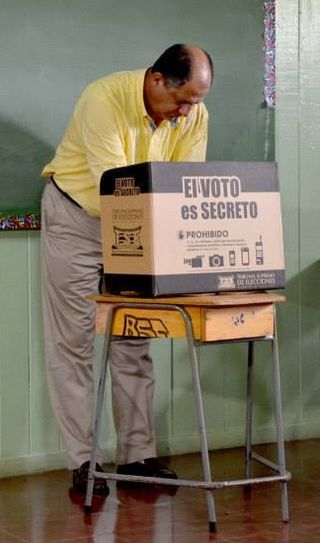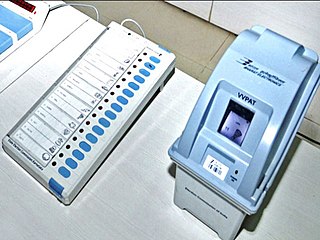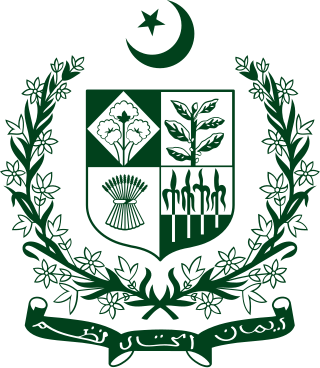Related Research Articles
The electoral system of Australia comprises the laws and processes used for the election of members of the Australian Parliament and is governed primarily by the Commonwealth Electoral Act 1918. The system presently has a number of distinctive features including compulsory enrolment; compulsory voting; majority-preferential instant-runoff voting in single-member seats to elect the lower house, the House of Representatives; and the use of the single transferable vote proportional representation system to elect the upper house, the Senate.

The secret ballot, also known as the Australian ballot, is a voting method in which a voter's identity in an election or a referendum is anonymous. This forestalls attempts to influence the voter by intimidation, blackmailing, and potential vote buying. This system is one means of achieving the goal of political privacy.

Electronic voting is the standard means of conducting elections using Electronic Voting Machines (EVMs) in India. The system was developed for the Election Commission of India by state-owned Electronics Corporation of India and Bharat Electronics. Starting in the late 1990s, they were introduced in Indian elections in a phased manner.
"None of the above" (NOTA), or none for short, also known as "against all" or a "scratch" vote, is a ballot option in some jurisdictions or organizations, designed to allow the voter to indicate disapproval of the candidates in a voting system. It is based on the principle that consent requires the ability to withhold consent in an election, just as they can by voting "No" on ballot questions. It must be contrasted with "abstention", in which a voter does not cast a ballot.
Elections in the United States are held for government officials at the federal, state, and local levels. At the federal level, the nation's head of state, the president, is elected indirectly by the people of each state, through an Electoral College. Today, these electors almost always vote with the popular vote of their state. All members of the federal legislature, the Congress, are directly elected by the people of each state. There are many elected offices at state level, each state having at least an elective governor and legislature. There are also elected offices at the local level, in counties, cities, towns, townships, boroughs, and villages; as well as for special districts and school districts which may transcend county and municipal boundaries.
An absentee ballot is a vote cast by someone who is unable or unwilling to attend the official polling station to which the voter is normally allocated. Methods include voting at a different location, postal voting, proxy voting and online voting. Increasing the ease of access to absentee ballots is seen by many as one way to improve voter turnout through convenience voting, though some countries require that a valid reason, such as infirmity or travel, be given before a voter can participate in an absentee ballot. Early voting overlaps with absentee voting. Early voting includes votes cast before the official election day(s), by mail, online or in-person at voting centers which are open for the purpose. Some places call early in-person voting a form of "absentee" voting, since voters are absent from the polling place on election day.
Voter verifiable paper audit trail (VVPAT) or verified paper record (VPR) is a method of providing feedback to voters who use an electronic voting system. A VVPAT allows voters to verify that their vote was cast correctly, to detect possible election fraud or malfunction, and to provide a means to audit the stored electronic results. It contains the name and party affiliation of candidates for whom the vote has been cast. While VVPAT has gained in use in the United States compared with ballotless voting systems without it, hand-marked ballots are used by a greater proportion of jurisdictions.

Elections in Barbados are held to choose members to fill elective offices in the House of Assembly. Elections are held on Election Day. These general elections do not have fixed dates, but must be called within five years of the opening of parliament following the last election. A former minister of the DLP, Warwick Franklin summed up the general elections process in Barbados as saying it is really just, "30 by-elections on the same day."
India has a parliamentary system as defined by its constitution, with power distributed between the union government and the states. India's democracy is the largest democracy in the world.

Since its establishment in 1947, Pakistan has had a non-symmetric federal government and is a federal parliamentary democratic republic. At the national level, the people of Pakistan elect a bicameral legislature, the Parliament of Pakistan. The parliament consists of a lower house called the National Assembly, which is elected directly via first-past-the-post voting, and an upper house called the Senate, whose members are chosen by elected provincial legislators. The head of government, the Prime Minister, is elected by the majority members of the National Assembly and the head of state, the President, is elected by the Electoral College, which consists of both houses of Parliament together with the four provincial assemblies. In addition to the national parliament and the provincial assemblies, Pakistan also has more than five thousand elected local governments.

The Electoral Administration Act 2006 is an act of the Parliament of the United Kingdom, passed on 11 July 2006.

A teller is a person who counts votes in an election, vote, referendum or poll. Tellers are also known as scrutineers, poll-watchers, challengers or checkers.
Electronic voting by country varies and may include voting machines in polling places, centralized tallying of paper ballots, and internet voting. Many countries use centralized tallying. Some also use electronic voting machines in polling places. Very few use internet voting. Several countries have tried electronic approaches and stopped because of difficulties or concerns about security and reliability.

The Election Commission of Pakistan (ECP) is an independent, autonomous, permanent and constitutionally established federal body responsible for organizing and conducting elections to the national parliament, provincial legislatures, local governments, and the office of president of Pakistan, as well as the delimitation of constituencies and preparation of electoral rolls. As per the principles outlined in the Constitution of Pakistan, the Commission makes such arrangements as needed to ensure that the election is conducted honestly, justly, fairly and in accordance with law, and guard against corrupt practices. The Election Commission was formed on 23 March 1956.
There are five types of elections in the United Kingdom: elections to the House of Commons of the United Kingdom, elections to devolved parliaments and assemblies, local elections, mayoral elections, and Police and Crime Commissioner elections. Within each of those categories, there may also be by-elections. Elections are held on Election Day, which is conventionally a Thursday, and under the provisions of the Dissolution and Calling of Parliament Act 2022 the timing of general elections can be held at the discretion of the prime minister during any five-year period. All other types of elections are held after fixed periods, though early elections to the devolved assemblies and parliaments can occur in certain situations. The five electoral systems used are: the single member plurality system (first-past-the-post), the multi-member plurality, the single transferable vote, the additional member system, and the supplementary vote.

The Delhi Legislative Assembly election was held on 4 December 2013, with the result announced on 8 December resulting in formation of the Fifth Legislative Assembly of Delhi.

The Election Commission of India (ECI) is a constitutional body established by the Constitution of the Republic of India empowered to conduct free and fair elections in the Republic of India. It is headed by a chief election commissioner and consists of two other election commissioners as constituent members.

Noksen is one of the 60 Legislative Assembly constituencies of Nagaland state in India. It is part of Tuensang district and is reserved for candidates belonging to the Scheduled Tribes.
Totaliser is a proposed mechanism in the voting machines in India to hide the booth-wise voting patterns. A totaliser allows the votes cast in about 14 polling booths to be counted together. At present, the votes are tallied booth by booth.

None of the Above, abbreviated as NOTA, has been provided as an option to the voters of India in most elections since 2013. By expressing a preference for none of the above, a citizen can choose not to vote for any candidates who are contesting the elections.
References
- 1 2 The Conduct of Elections Rules, 1961 Archived 2014-06-07 at the Wayback Machine
- ↑ "Counting of votes tomorrow; nearly 8,000 candidates for 543 LS seats | Business Line". www.thehindubusinessline.com. Archived from the original on 2014-05-17.
- 1 2 Wilfred, K. F. (11 October 2013). "Provision for "None of the above" option on the EVM/Ballot Paper- Instructions" (PDF). Election Commission of India. Archived from the original (PDF) on 2018-07-13. Retrieved 2014-01-24.
- ↑ Proposed electoral reforms Archived 2011-07-21 at the Wayback Machine
- ↑ Clarification of 49-O from Election Commission of India
- ↑ Singh, Abhimanyu (17 April 2011). "Anna's next target is electoral reform". The Sunday Guardian. Retrieved 24 April 2011.